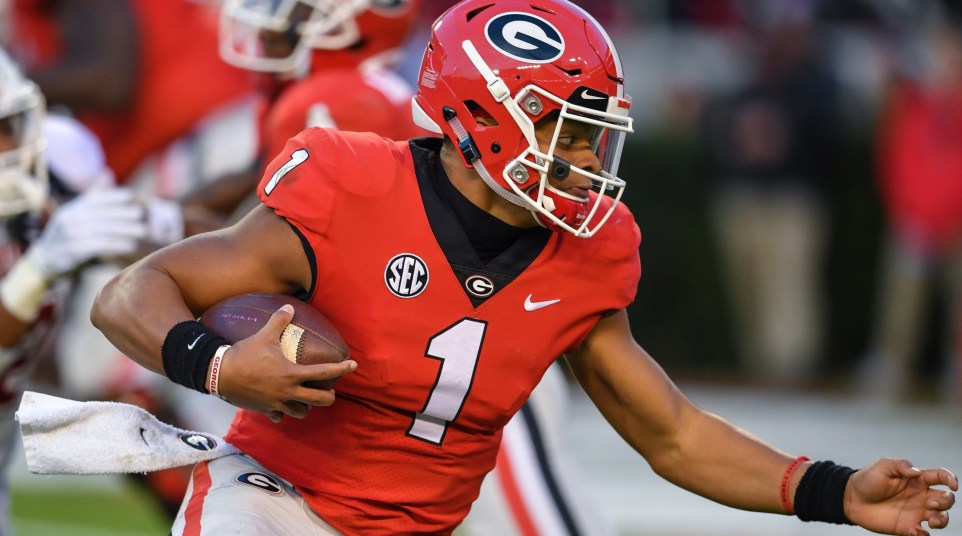
Of course the NCAA was going to tighten up the transfer portal
If you thought the NCAA was going to sit on its hands and let the transfer portal continue in its chaotic fashion, well, I bet Wednesday’s news was like a knee-buckling curveball.
But if you’ve been reading the tea leaves with this whole thing — basically listening to coaches complain about it — then Wednesday’s news was like center-cut fastball on a 3-0 count. You saw it coming, looked it into the glove and let it pass on by.
USA Today’s Dan Wolken reported that the NCAA was set to approve new “guidelines” that would essentially make it more difficult for a transfer to obtain a waiver.
Why is that significant, you ask? In an offseason in which quarterbacks Tate Martell and Justin Fields were granted immediate eligibility after transferring schools as underclassmen while the former Georgia tight end Luke Ford (Illinois) and Coastal Carolina offensive lineman Brock Hoffman (Virginia Tech) had their waivers denied by the NCAA, public outrage ensued over the subjectivity of the process, and understandably so.
It seemed like waivers for immediate eligibility were granted to those who were big-time quarterbacks and denied to those who weren’t.
Under the previous system, immediate eligibility was granted to athletes with “documented mitigating circumstances outside of the student-athlete’s control and directly impacts the health, safety or well-being of the student-athlete.”
Um, no wonder this thing was so subjective. The NCAA went on a case-by-case basis but didn’t factor common sense into its rulings. So instead, the NCAA decided to make life easier on itself. They added the words “extenuating and extraordinary” to the guideline. In other words, it has to be extreme.
And no, Martell realizing he wasn’t going to play under the new coach wasn’t extreme.
Here’s the other interesting thing about this, and it relates to Martell’s rather typical situation. Read this straight from the NCAA’s release announcing the new transfer portal guidelines:
When a school requests a waiver because it asserts a student-athlete no longer has the opportunity to participate at his or her previous school, the new school must provide proof that the student-athlete is in good academic standing and meeting progress-toward-degree requirements at the new school and a statement from the previous school’s athletics director indicating whether the student could return to the team; whether the student was dismissed from the team and the date of dismissal; whether the student was in good academic standing at the time of departure; and the reasons the student gave the previous school for the transfer.
Under these new guidelines, you now need a statement from the previous school’s A.D. basically saying that “Player X” is in accordance with all of these rules and indeed worthy of immediate eligibility.
Call me crazy, but that seems like a stopgap. That seems like a backdoor way to get coaches back involved in this process. It wasn’t long ago when coaches had freedom to restrict a player from transferring to a certain school. This sort of feels like the NCAA’s way of doing that while keeping the coaches’ hands clean.
Is that fair? Not necessarily. Was a change like this inevitable? Absolutely.

Credit: Robert Deutsch-USA TODAY Sports
The whole point of this is to de-incentivize the transfer portal and the belief that immediate eligibility is possible if you know what cards to play with the NCAA to get a waiver. The NCAA hopes that players will think twice about entering the transfer portal if their odds of getting a waiver for immediate eligibility decrease. It’s simple. The more steps there are to do something, the less likely one is to do it.
A few weeks ago, I wrote about the changes that I thought the transfer portal needed. SEC Commissioner Greg Sankey referenced how wild it was that there were more players in the transfer portal than available FBS scholarships, which was a sign that regulation was coming from the NCAA.
My suggestions were only allowing a player to enter the transfer portal once — we’d avoid the Chris Steele/Bru McCoy situations — and putting a timeframe on the portal. People forget that we haven’t even experienced our first August with this yet. Who knows what’s going to happen in fall camp when the depth chart comes out and a bunch of Power 5 players see that they aren’t starting.
To me, that’s why this timing made a ton of sense. About a month before fall camps open, the NCAA did something that will be criticized heavily, but there might actually be some benefits for once.
(And that’s how you give a backhanded compliment.)
Is the transfer portal perfect? No. I’d at least like to get to the point where if a player reached a certain number of credit hours and they’re still in good academic standing, they could get immediate eligibility even as an undergraduate student. After Wednesday’s news, that seems more likely than the alternative. That is, nobody has to sit out a year after transferring and waivers are no longer necessary because everyone has immediate eligibility.
But I’m not standing in the batter’s box sitting on that pitch. That would be a knee-buckling curveball for everyone.
